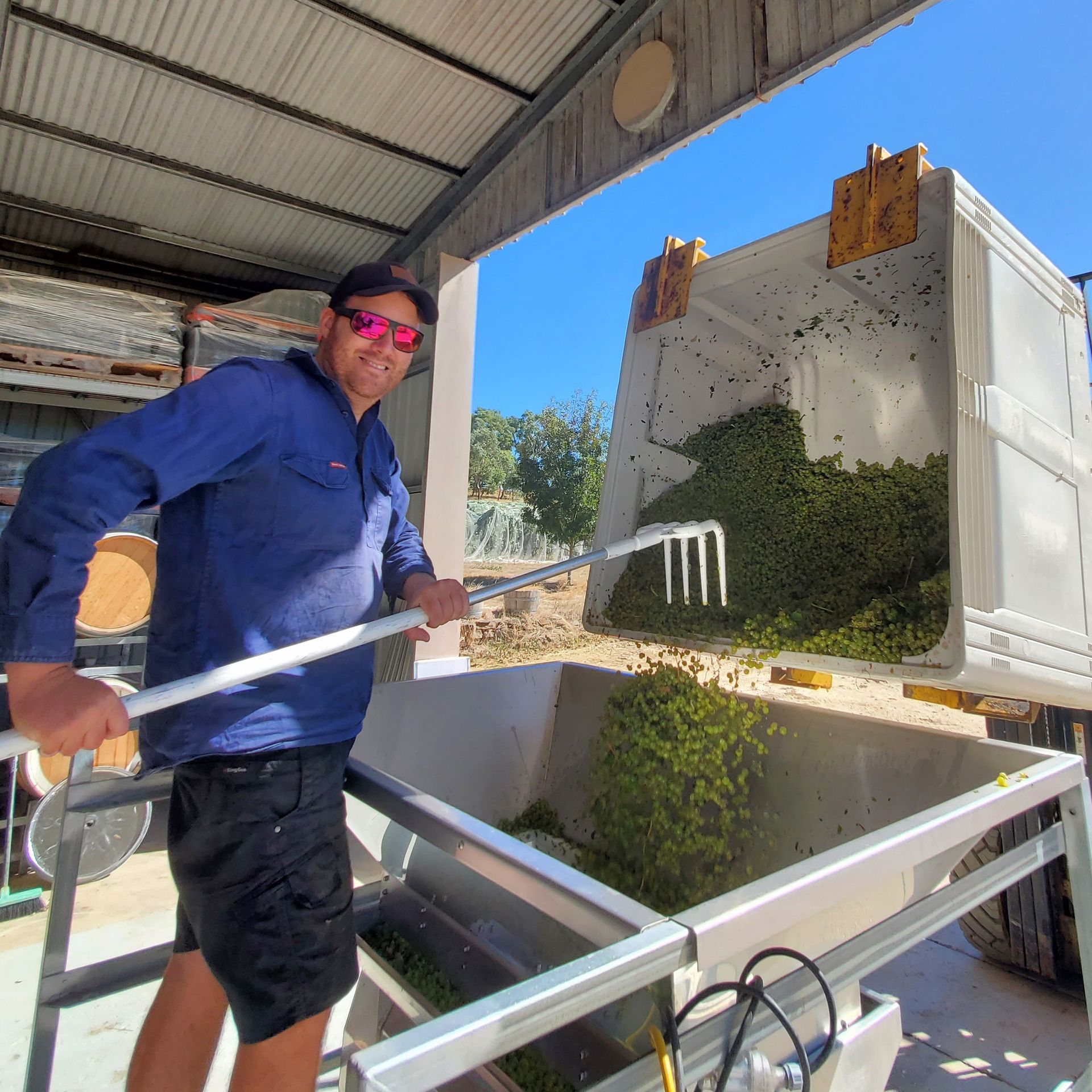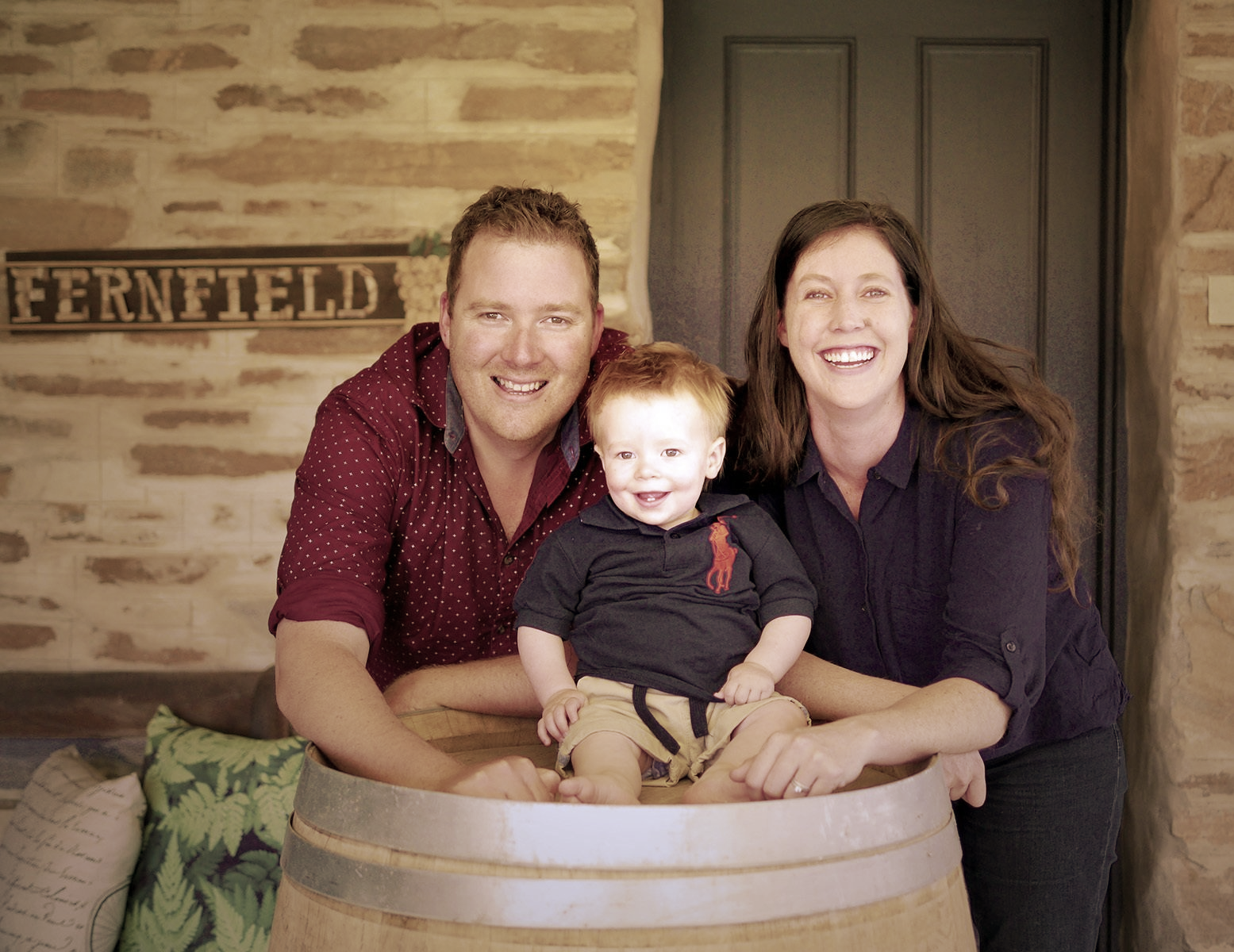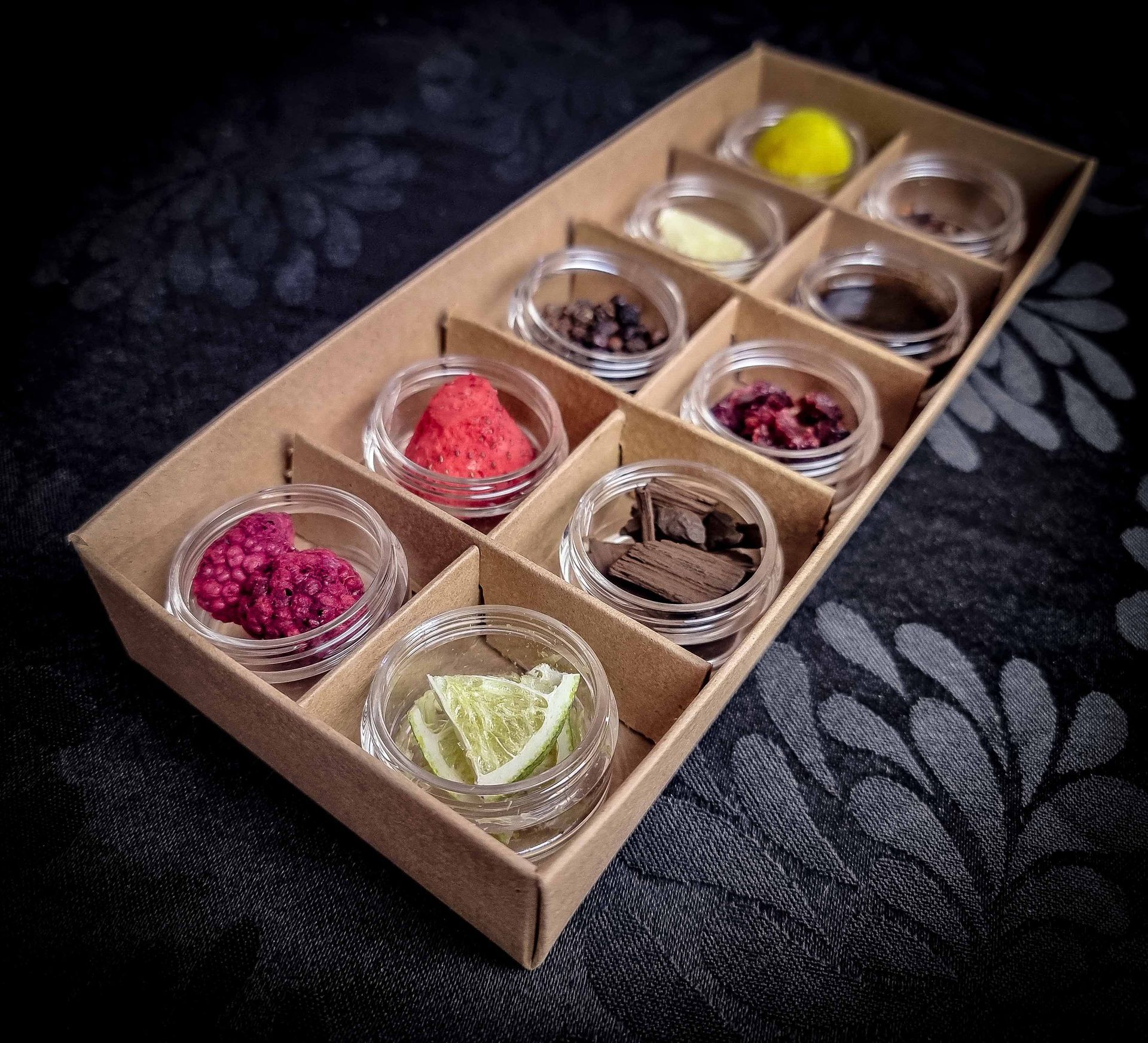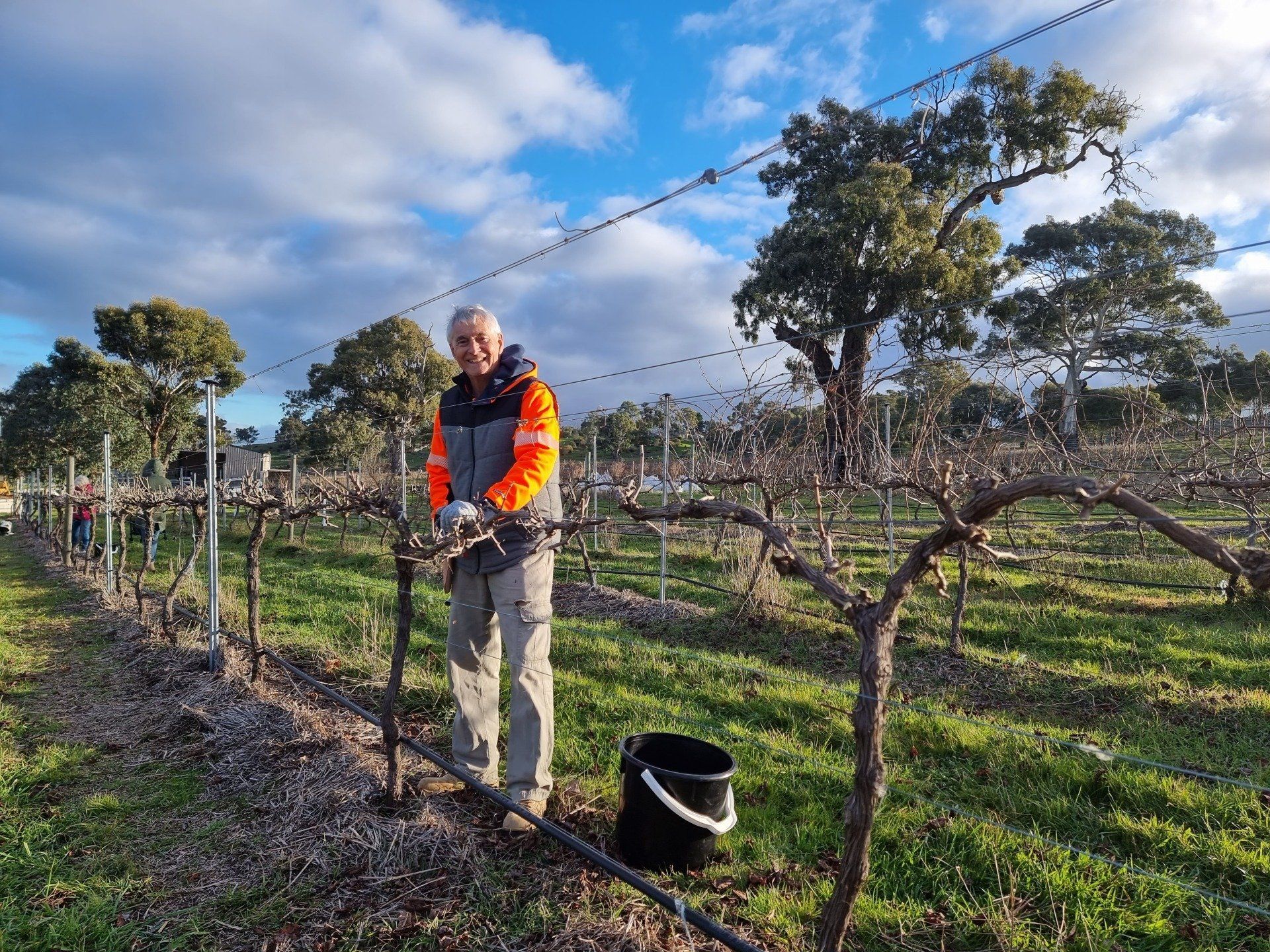What's New
Read our latest blog articles
Here we share our news, provide insight into grape-growing and winemaking, and give you our best tips for enjoying wine (and wineries!).
Something you want to hear about? Use the search bar below to see if we've written about it before, and if not, get in touch at rebecca@fernfieldwines.com.au and we'll write about it for you!

14 Mar, 2024
It's vintage time in the Barossa! In between picking, pressing and fermenting grapes, Scott and I are still meeting our customers at the cellar door each Friday, Saturday, Sunday and Monday. Below are answers to some of the most common questions we are asked during vintage time. How do we decide when to pick grapes? We use a range of factors to choose when to pick the grapes, with the most important being the various aspects of 'ripeness' of the fruit. these aspects include: Baume: This is the sugar content, and therefore alcohol potential, of the grape. Whites are usually ripe at around 10.5-13.5 Baume, and reds at 13-15 Baume, and in March conditions in Eden Valley most varieties ripen at about 0.8-1 Baume per week. This is a good rough indicator but because seasons and vineyards vary, it's not enough to know if the grape is ripe. Acidity: We measure the pH, and the 'titratable acidity' of juice, and it's more important in whites than reds. The titratable acidity is a better measure of how the wine will taste, a juice above 8.5g/L acidity will often be too tart (depending on the variety, style and sweetness we're aiming for), and many years we pick whites as soon as the acidity has dropped past 8.5. Grape taste & looks: As well as these simple measurements, we also look at a range of factors on the grape itself: How plump it feels, the colour of the seeds and stems, how thick the pulp is, and how the juice and skins taste. Based on these ripeness aspects, we will look at the weather forecast to predict how long it is until the grape is ready to pick. Hot weather ripens faster than cold, up to about 36deg. Above 36 it's possible for the vines to shut down and stop ripening entirely until the weather cools down, so it's important we test grapes just before and after heatwaves like the one we've just had. As we get closer to ripe we will test more and more often, to drill down to the exact date we want to pick. What do you do with the pressed grape skins? We feed them to our sheep!

05 Mar, 2021
Managing our little cellar door during COVID has resulted in a number of learnings for us including a surprise one, that both our visitors and us have really enjoyed our booked experiences. Making an appointment means we can do a range of fun wine experiences which just can't work when we're flat out with lots of guests. This more personalised experience means plenty of one-on-one time to not only learn about our wines and all the winemaking, but also adapting to what you're feeling on the day such as a tour, getting through all the questions you might have about wine, maybe a little of the latest local banter or a serene picnic out on our lawn doing your own thing. We know sometimes booking can be a chore, so we've made it as easy. We've set it up so you can book on our website, directly from Facebook or Google, the old fashioned way by just giving Bec a call on 0402 788 526 or send through an email on rebecca@fernfieldwines.com.au. We are really happy to have you visit whatever way works best for you. Unique Experiences

22 Oct, 2020
I ntroduction: An Imperfect Science There's often talk of wine tasting being an art, rather than a science. Wine chemistry is definitely a complicated form of science, but the current technology just isn't good enough to measure many wine aromas, and here arises the art. For example, a recent study on wine compounds called mercaptans* could measure down to a very impressive 0.0000000001%, however the human nose can still detect smaller quantities 1 .
Stay Social
Follow our #fernfieldwines adventures on Instagram
-
Cracking day for wine tasting! #boutique #winery #EdenValleyButton
-
Had this rainbow following me while testing the grapes, hopefully a good omen of things to come 🤞 #boutique #husbandandwife #vineyard #BarossaButton
-
We have a winner for our Experience Eden - Wine & Cheese Pairing Pack Congratulations Rachel Bigg @rachyjoy_4 Sorry to those that missed out! If you got the excited to try it out or thought it might make a great gift, you can find it on our website: www.fernfieldwines.com.au/experience-edenButton
-
We're giving away an Experience Eden Wine Pack valued at $185 RRP! We've been at it again, doing the hard yards for you of tasting and testing numerous wine and cheese pairings to put together a pack of the most tasty, fun and interesting pairings we could find. The pack has four wines and four cheeses and guided tasting notes, with a RRP value of $185 Just like & comment "I love wine & cheese" to be in the draw. Also available to enter on Facebook. Winner will be announced next Friday 🎉Button
-
Our little man helping out with picking and crushing Grenache this weekend. Certainly knows how to get dirty 😅Button
-
Did anyone catch the incredible reds in the sky tonight!? Side note; this old gum is one of our favourites and features on our "The Old River Red" wine label range and I thought I'd give a quick heads up that we have our next vintage Shiraz Cabernet just about to release and we're hoping you'll find it a cracker!Button
-
There are some benefits to the night shift sauvy picking, like the cool breeze and moonlight scenes #vineyard #boutiquewines #harvest24photocompButton
-
Vintage has kicked off with our Eden Valley Sauvy! Already packed full of tropical fruit, we can't wait to see how it comes together and share it with you all. For those doing our winery tours, we'll make sure you get to taste where it's at in it's journey. Riesling is just around the corner.Button
-
Lovely colours this eveningButton
-
Today we celebrate our little legend Bandit's 10th year amongst the vines with usButton
-
Sorry team, we're closed this weekend (Saturday & Sunday) for beach adventures and to catch up with family that are heading overseas. Open today and see you again on Monday.Button
-
Hanging out in the vineyard with my little friendButton
-
The sun sets on a hot day in the vineyard #EdenValley #Barossa #SunsetButton
-
PSA our barrel fermented rose' is back! #boutique #rosé #EdenValleyButton
-
As the land turns to golden hues, the lush green of the vineyard sets the contrast #farmlife #vineyard #wineButton
-
Have you looked outside today? I hope you can follow a road that leads you to sunshine and good wine!Button
-
Lazy Sunday arvos next to the old horse hitching postButton
-
All the shoutouts to Amy @splitpants_productions pictured here celebrating with us after the Wayward Girl WON the national PackWine 'Best Classic Package Design'. Amy's beautiful painting of the Wayward Girl is now proudly hanging in the cottage that inspired the label.Button
-
Dozing in the sunButton
-
Tough for someButton
-
Cracka of an arvo for it! #Handmade #vineyardButton
-
Excited to open today's Grapegrower and Winemaker magazine and see three of our wines featured as full page photos! Thanks to the genius of @splitpants_productions, we're finalists in tomorrow's @packwineexpo design awards in three different categories. Wish us luck!Button
-
Vintage done and time for a clean upButton
-
Last grapes through the crusher today!Button
-
When you've had a couple cheeky Barossa Shiraz and are sure you've got away with it #barossa #Shiraz #farmlifeButton
-
Big day of Shiraz pressing today 👌Button
-
Around the clock care sometimes means wine plunges in dressing gowns and slippers #boutiquewinelifeButton
-
Beautifully rich and dark Merlot this year. A particularly big thanks to the pruning team (our family) for putting up with our pedantic requirements, but it has thankfully paid off 👌🤙Button
-
A healthy rose' getting a rack and returnButton
-
Somebody is pretty happy to have a picnic at our rocks on the hill today.Button
-
Nets are off and the next batch of our barrel fermented "All Peachy Rose' " is under wayButton
-
Big cheers to Eden Valley Tourism & The Rowdy Group for putting together this video of our little winery! A good time to mention we're open all Easter long weekend from 11-4pm, come out and say g'day and enjoy a drive through Eden Valley.Button
-
Barrel fermented Chardonnay #boutique #winemakingButton
-
We thought 96pts for our Sauvy from Winestate was worth chucking on the gold sticker #boutique #sauvignonblanc #WinnerButton
-
The first grapes have arrived for vintage #EdenValley #boutiquewineButton
-
Meet our Aunty Buzzy! One of the benefits of running your own business that we've more recently been working out, is that you can pick out and work with talented and fun people. We're excited to be able to introduce our Aunty Buzzy who is a very talented baker and it is just awesome to be able to collaborate with her. Scott has so many fond memories enjoying Buzzy's cooking while growing up. Buzzy has always been the preferred caterer for big family events, somehow whipping up amazing meals to feed an army in no time. This demand gradually expanded into the wider community and eventuated in her opening her own bakery last year. Black Rock Kitchen has quickly become the place for baked goods in and around Orroroo, with her sweet and savoury creations selling out early every week. Next time you're in the Flinders you'll have to have a trip to 54 31 Collective, a community shop featuring local art, jewellery, clothing, gifts, and obviously delicious baked goods! For us Aunty Buzzy has knocked up a custom apple, pistachio, coconut and lime biscotti to pair with our Riesling and sesame seed and cracked pepper lavosh to pair with our Merlot. You can find these in our latest "Experience Eden" packages online or just give us a call.Button
-
Plenty happening in the vineyard as the colours of veraison start to show #boutique #winery #veraisonButton
-
A few snaps from a busy season in the vineyard. Spring rain has meant big canopies and a lot of hands on canopy management, but it is so far looking promising. Here's to a good finish!Button
-
Shameless promotion of an achievement, we got a win! Our Gold Leaf Reserve label won the Australia & New Zealand Wine Label Award, which is pretty cool for our little winery and our label designer Amy Herman at Splitpants Productions. Be sure to check her out if you need graphic design or custom artwork done!Button
-
Check out this little guyButton
-
Some strange weather in the hills tonight giving off a beautiful sunsetButton
-
We are shut tomorrow (Friday) for very important work related things, sorry team! #familybusiness #rnr #beachcampingButton
-
We've got all your summer essentials sorted - well wine and BBQ gear anyway, and who needs anything else? Our summer Experience Eden gift package is on sale until Friday and includes these four wines, BBQ tongs and your own Fernfield BBQ apron, along with important tasting notes such as the best Dad-Jokes to tell while BBQing. Get it posted to you or directly to a friend for a wine-derful xmas present https://www.fernfieldwines.com.au/experience-eden for deets and to order. #fernfieldwines #giftbox #experienceeden #dadjokesButton
-
Finding a good spot to hide #storm #rainy #farmlifeButton
-
Nice arvo for checking through our wines #boutique #winemakingButton
-
Thunderstorm rolling through #EdenValley #OldRiverRed #ScarTreeButton
-
Happy dogsButton
-
New lambs first wobbly step and jumpButton
-
I'm supposed to be taking photos of our His & Hers Experience Eden package which is going out next week, but since Hers is so much better than His, I had to stop for a snack 😂🍊👩 #Hersisalwaysbetter #ExperienceEdenButton
-
We have a new release of 'The Wayward Girl'! In keeping with the Wayward Girl tradition, it's one of our lighter reds, an easy drinking Bordeaux-style blend of Cabernet Sauvignon, Cabernet Franc and Merlot. This vintage is a touch riper in character than the 2017, with more blackcurrant, along with herbs & spices on the nose, and gentle tannins on the palate. Another tradition of the Wayward Girl is the ever-changing girls on the label. For this vintage, local artist and friend Amy Herman @artbyamyherman painted our 'Wayward Girl' (the painting is now hanging up in our house) and we love the way the label goes with our new caps. Come and try at our cellar door or online at https://www.fernfieldwines.com.au/the-wayward-girlButton
-
A nice evening for itButton
-
Little mate in the vineyardButton
-
Everyone getting through the chilly weather ok? I love crunching through the vineyard when the sun is out 👍 #brrr #wintervibesButton
-
Hey check this out, five stars & 95 points! 👌 We've just had this cracka review come in for our Gold Leaf Reserve Shiraz; "It's superbly ripe and richly expressed with dark fruit intensity, cake spice, cedar and dark cocoa characters on the nose, leading to an impressively concentrated palate that's plush and expansive. Multi-layered and wonderfully complex with a lengthy structured finish. At its best: now to 2032. $64.00. www.fernfieldwines.com.au" Sam Kim @ Wine Orbit We'd love to share with you the final wine behind years of work, come and catch up with us sometime in Eden Valley.Button
-
Frosty in Eden Valley this morning! #sunrise #barossaButton
-
Beautiful colours lighting up the old river redgum trees tonight #OldRiverRed #EdenValley #BarossaButton
-
Bottling underway for our new Wayward Girl. Loving our new bottling gear and our new label 🙂Button
-
Juicy juicy green grass certainly a benefit of the recent rains 👌Button
-
A lot of fun packaging up your latest Experience Eden wine packages! The winter package as has become tradition, is our in-house made artisan chocolate tailored to match specific wines from our range. Can't wait to hear your take on how we did 🍫🍷Button
-
Lovely afternoon for contemplating all the thingsButton
-
Definitely enjoying the sneaky bits of sunshine #countrylife #bordercollieButton
-
Becky has been busy making our chocolate pairings and you have just one day left to try it! Check out our website to get your Experience Eden Pack 👌 #artisan #chocolate #perfectpairingButton
-
Took this one a week back capturing the end of Autumn colours #barossa #natureButton
-
Me little mateButton
-
Dewy morningsButton
-
Having a lot of fun with a range of experiences at the cellar door #boutiquewine #perfectpairingButton
-
There's quicker ways to fill your grape picking bucket #CheekyMonkeyButton
-
Loving the autumn colours and calming feel of vineyard that's done its job for for the year #ThisIsOurEdenButton
-
A few highlights from picking our Cabernet #boutique #family #winemakingButton
-
Come for a drive and catch us all long weekendButton
-
Little batch winemakingButton
-
One of my little mates in the vineyard. Actually kinda cute when you aren't copping a face full web while inspecting the vineyard 😄Button
-
The severe thunderstorm warning has passed, just lucky nobody was sitting on the long drop or they may have had something scared out them 😅 Hope you've all faired ok 👍Button
-
Heads up everyone, last day to grab Autumn Experience Eden package themed... "Best Of The Barossa" Learn more and grab it from our website 🤙Button
-
Vintage has officially kicked off overnight with Sauvy coming in and looking 👌 #vintage2022 #husbandandwifeteamButton
-
Woo hoo, thought we'd better get our neighbour and Riesling vigneron Mark 'Barty' Bartholomeus into this one as our Riesling just received a top wine of class and gold medal at the National Cool Climate Wine Show!Button
-
The young fella getting amongst it 🤙👍Button
-
Our final staff member has had his jab, ready for us to re-open our cellar door soon!Button
-
Taking in the sky this evening 👌 #OldRiverRedButton
-
Becky sitting back having a well earned celebratory drink after a win tonight of the Cellar Door Wine Communicator of the Year 😯👍 #WCAAwards #winecommunicator #WineIndustryButton
-
One of our new girls 'Minny'Button
-
Thanks for everyone checking in on us! Although we haven't come out of it unscathed, we have missed the extreme damage of some unlucky buggas. A few shoot adjustments and careful monitoring of disease should hopefully see us have a good vintage. #FarmingLife #haildamage #muchloveButton
-
How's everyone holding up?! Power out and a touch of hail damage here. #storm #hail #barossa #wineryButton
-
And just like that, the lights go outButton
-
Yeeewww, proud of Becky and her efforts to make learning all things wine fun and she's just been recognised becoming a finalist for "Best Wine Communicator, Cellar Door"Button
-
Perfect arvo for dozing in the sun #HappyPupButton
-
My chief post hole marker 🤏👌 (everything is now painted orange) The Cabernet is getting a canopy upgrade following the success this vintage in our Shiraz. It will be a signature mix for the location of smart-dyson, solar collector and lazy ballerina. #boutique #family #vineyardButton
-
Thanks for the messages coming in sharing your fun with our Experience Eden wine and cheese pairings. We just thought we needed to check again, and can confirm we still like the pairings 😆😉 #ExperienceEdenButton
-
Awesome surprise to have this cute little guy pay us a visit and then pop back into our revegetation area. #Barossa #EdenValley #NatureButton
-
Barossa bike trails with the familyButton
-
So this happened today, our first proposal our cellar door! 🥰 Very exciting and big congrats to you two! 🥂Button
-
Working hard, or hardly working? Scott's been busy tasting cheeses with wines for our upcoming Experience Eden package. To make us feel like we were achieving something whilst eating and drinking, we also wrote a blog on how to pair wines with cheese: https://www.fernfieldwines.com.au/the-cheesiest-of-wine-pairings. #experienceeden #fernfieldwines #wineandcheeseButton
-
Creek adventures racing ducksButton
-
Just a man and his dogButton
-
Excited to be nearing the end of pruning and getting ready for trellis upgrades for the Cabernet vineyard. Loving our trellis combo in the Shiraz of Smart-Dyson + Solar Collector + Lazy Ballerina. A custom job to perfectly suit our little mircroclimate 😉 #boutique #winery #actionButton
-
Great weekend for a bit of all this #familywinery #familyfunButton
-
Come drop in and hear the story behind the wine from the winemaker. This long weekend no booking required 👍🍷 #boutique #wine #EdenValleyButton
2020 | Copyright Fernfield Wines
2019 | Copyright Fernfield








































































































